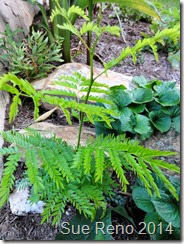
I posted in the spring about the big changes in my garden—taking down a huge locust tree, and revamping the vegetable plot. The autumnal equinox is a good time to report in on how things evolved from there. In a word—fantastic! The tree, and the shade it provided, were missed, but opening up the garden to the full sun, and removing the competition from the tree roots, gave me my best garden success in many years. It also helped that I rototilled in a lot of compost, and that the weather was cooperative, with plenty of sun and rain. As an aside, the locust did not give up the fight readily, sprouting small saplings from the root structure all over the yard.
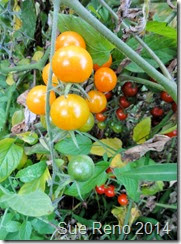 The tomatoes were excellent. No blight or disease, and a big crop of 6 different varieties for snacking and cooking. They are still going strong.
The tomatoes were excellent. No blight or disease, and a big crop of 6 different varieties for snacking and cooking. They are still going strong.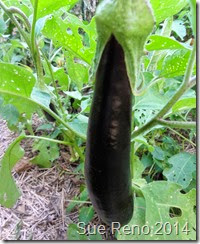 The eggplants exploded. I had several varieties, the round Italian types and the long Japanese, and they were both abundant, tender, and sweet without bitterness.
The eggplants exploded. I had several varieties, the round Italian types and the long Japanese, and they were both abundant, tender, and sweet without bitterness.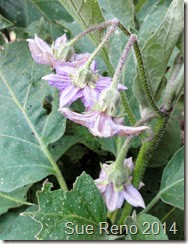 They are still covered with blossoms, although at this point they have little chance of maturing into fruits.
They are still covered with blossoms, although at this point they have little chance of maturing into fruits. 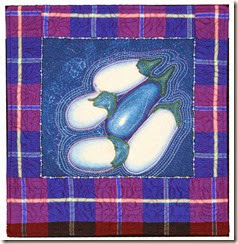 Years ago I made a small art quilt with a cyanotype print of eggplants from that year’s garden.
Years ago I made a small art quilt with a cyanotype print of eggplants from that year’s garden.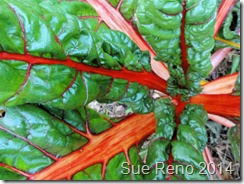 I planted two long rows of rainbow swiss chard and have been overwhelmed by it, in a good way. I put it in (almost) everything I cook, and eat the small leaves raw. It will last until hard frost and then I will miss it terribly.
I planted two long rows of rainbow swiss chard and have been overwhelmed by it, in a good way. I put it in (almost) everything I cook, and eat the small leaves raw. It will last until hard frost and then I will miss it terribly. 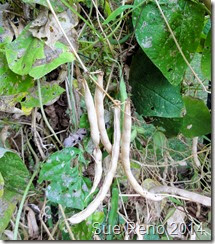 I had both bush beans and Kentucky wonder pole beans. The pole beans grew so enthusiastically that I fell behind in picking them, and quite frankly I grew a bit tired of beans. So there are a lot of them there to shell out as soup beans, if I find the time and make the effort.
I had both bush beans and Kentucky wonder pole beans. The pole beans grew so enthusiastically that I fell behind in picking them, and quite frankly I grew a bit tired of beans. So there are a lot of them there to shell out as soup beans, if I find the time and make the effort.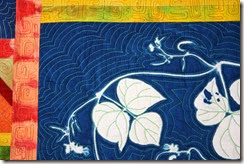 Kentucky wonder bean vines are a cyanotype feature on my art quilt The Organic Garden.
Kentucky wonder bean vines are a cyanotype feature on my art quilt The Organic Garden.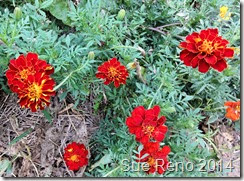 In the spring I randomly planted marigolds here and there in with the veggies, and they have flourished as well.
In the spring I randomly planted marigolds here and there in with the veggies, and they have flourished as well.
The fennel still has a few Black Swallowtail caterpillars feasting on it. These latecomers to the party will go into chrysalis form to spend the winter.
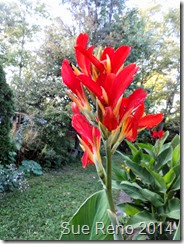 Each year I plant tall red cannas. The rhizomes are not hardy here in Pennsylvania, so I dig them and store them indoors over the winter. This year I had a bunch of them crop up unexpectedly in a bed some distance away; my assumption is that squirrels buried some seed pods. This is very unusual in my experience. Their blooms are all different shades of reds and soft oranges, proof that genetics is a wonderful thing.
Each year I plant tall red cannas. The rhizomes are not hardy here in Pennsylvania, so I dig them and store them indoors over the winter. This year I had a bunch of them crop up unexpectedly in a bed some distance away; my assumption is that squirrels buried some seed pods. This is very unusual in my experience. Their blooms are all different shades of reds and soft oranges, proof that genetics is a wonderful thing.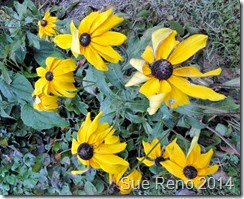
In the landscape beds, the black eyed Susan flowers had a good year. They are starting to fade out in a blowsy, lovely manner.
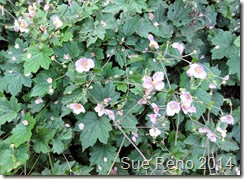 The ever reliable Japanese anemones are putting on their fall show.
The ever reliable Japanese anemones are putting on their fall show.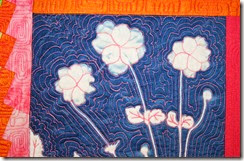 They are a cyanotype feature on my art quilt The Organic Landscape.
They are a cyanotype feature on my art quilt The Organic Landscape.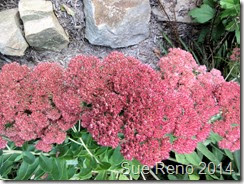
Equally reliable and beautiful are the stonecrops; this one is Sedum ‘Autumn Joy’.
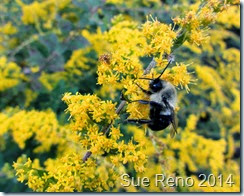 And last but not least, here is some goldenrod. It is NOT responsible for hay fever allergies, its pollen is heavy and not windblown. (The culprit is ragweed, which blooms at the same time.) It is covered with bees and wasps of all sorts during the day. As the sun sets, and the air cools quickly, some of the bees just stop and stay put until morning.
And last but not least, here is some goldenrod. It is NOT responsible for hay fever allergies, its pollen is heavy and not windblown. (The culprit is ragweed, which blooms at the same time.) It is covered with bees and wasps of all sorts during the day. As the sun sets, and the air cools quickly, some of the bees just stop and stay put until morning.I am not showing you the weeds that got away from me, and the various few things that did not do well this year. That is the gardener’s privilege, to focus on the beauty and the joy and the satisfaction of a job well done. Those will keep me fulfilled through the long winter, dreaming of next year’s glories.
For ongoing, macro image coverage of the local flora and fauna, check out my Flickr page.
As always, thanks for reading and commenting!
No comments:
Post a Comment